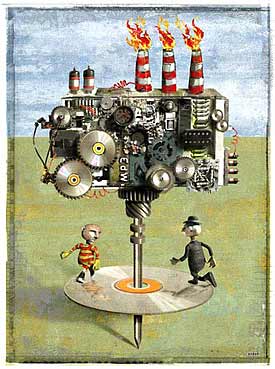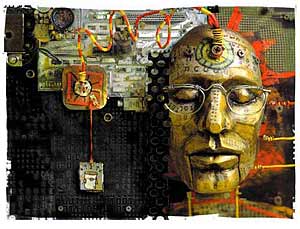The art of the Photoshoot
I'll spend the better part of July and a small chunk of August in a studio shooting apparel and accessories for the Corvette, Hummer and SSR catalogs for GM's licensing agency. Between the three catalogs there are about 500 shots of clothing and hard goods, with each having to be styled, lit, propped, photographed and color-corrected. It's a large project to say the least, and with any large project there are a few things that make it go smoothly.
Organize
I'm lucky enough to work with a project coordinator on this that has years of outstanding experience with these kinds of productions. Each piece of merch for the shoot is labeled with a tag that gives the product name, the catalog item number, notes on shot details and a host of other things. It's a ton of leg-work before the shoot, but it is worth it. The merch is organized by category as well, so we can shoot all the reflective hard goods on the same set with minimal lighting changes. All the apparel that will be on a form will be shot the same way.
For the first catalog, Corvette, I've penciled in each spread in the layout with detailed drawings of the styling, angle and positioning for everything. I've cross referenced each drawing with the information on the hang tag and made special shot notes where possible (need a close-up detail shot here, shoot this garment on a form, etc). Everyone has a copy of these layouts for reference.
Collaborate
When I was working in the photography end of the business, there were basically two kinds of Art Directors. The dictators had the "It's my way or the highway" attitude. There would be no real input from the photographer or stylist. Just shoot it the way I direct. Not much fun, to be honest, especially when that AD has hired truly talented, creative people to shoot.
Then there were the artists. The artist believes in the magic of collaboration. These ADs sit down with pencil layouts and say "Here's my idea, what do you think? Anything we can do to make it better?"
Both shooters on the project are old pros. They've shot a ton of work like this. The stylist has been around for a bit, too. All of them are great creative resources. We've already tweaked and changed those detailed pencil layouts on a couple of shots, because my drawings didn't translate as well into reality. So each shot is styled with flair. She has my layouts to start from, but she's "empowered" to say "This would look really cool if we did it this way".
The same goes for my shooters. I want their input. Not because I'm insecure in my layouts or design, but because I've learned that two creative minds are better than one.
Grease
The first few days of a big shoot are always stressful. Merch is missing or being changed. The props that were ordered are wrong. Getting the settings on the digital camera correct. I've found that one of the most important things I can do during that time is to keep a smile on everyone's face. Things are always out of kilter no matter how much one plans and organizes, and it all works out after a couple of days. So, I joke about the challenges. I keep a lighthearted attitude, and it's contagious. It's relaxes the client. There's plenty of time to be grumpy in three weeks, when everyone is sick of shooting this stuff. The more fun we have in the beginning, the longer it takes for the doldrums to set in.
Organize
I'm lucky enough to work with a project coordinator on this that has years of outstanding experience with these kinds of productions. Each piece of merch for the shoot is labeled with a tag that gives the product name, the catalog item number, notes on shot details and a host of other things. It's a ton of leg-work before the shoot, but it is worth it. The merch is organized by category as well, so we can shoot all the reflective hard goods on the same set with minimal lighting changes. All the apparel that will be on a form will be shot the same way.
For the first catalog, Corvette, I've penciled in each spread in the layout with detailed drawings of the styling, angle and positioning for everything. I've cross referenced each drawing with the information on the hang tag and made special shot notes where possible (need a close-up detail shot here, shoot this garment on a form, etc). Everyone has a copy of these layouts for reference.
Collaborate
When I was working in the photography end of the business, there were basically two kinds of Art Directors. The dictators had the "It's my way or the highway" attitude. There would be no real input from the photographer or stylist. Just shoot it the way I direct. Not much fun, to be honest, especially when that AD has hired truly talented, creative people to shoot.
Then there were the artists. The artist believes in the magic of collaboration. These ADs sit down with pencil layouts and say "Here's my idea, what do you think? Anything we can do to make it better?"
Both shooters on the project are old pros. They've shot a ton of work like this. The stylist has been around for a bit, too. All of them are great creative resources. We've already tweaked and changed those detailed pencil layouts on a couple of shots, because my drawings didn't translate as well into reality. So each shot is styled with flair. She has my layouts to start from, but she's "empowered" to say "This would look really cool if we did it this way".
The same goes for my shooters. I want their input. Not because I'm insecure in my layouts or design, but because I've learned that two creative minds are better than one.
Grease
The first few days of a big shoot are always stressful. Merch is missing or being changed. The props that were ordered are wrong. Getting the settings on the digital camera correct. I've found that one of the most important things I can do during that time is to keep a smile on everyone's face. Things are always out of kilter no matter how much one plans and organizes, and it all works out after a couple of days. So, I joke about the challenges. I keep a lighthearted attitude, and it's contagious. It's relaxes the client. There's plenty of time to be grumpy in three weeks, when everyone is sick of shooting this stuff. The more fun we have in the beginning, the longer it takes for the doldrums to set in.

